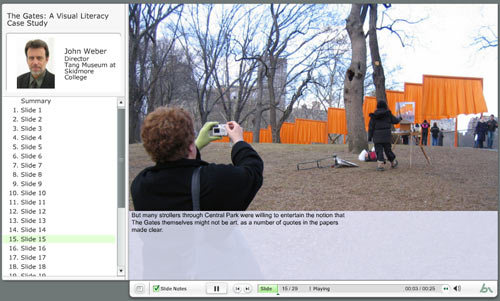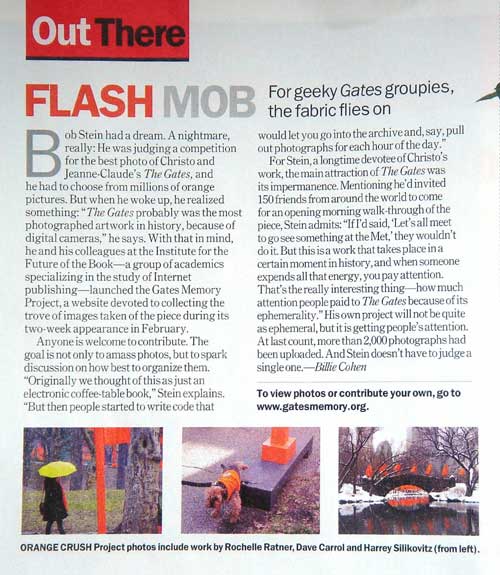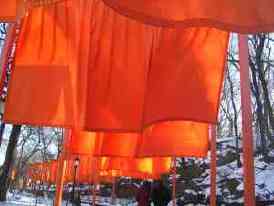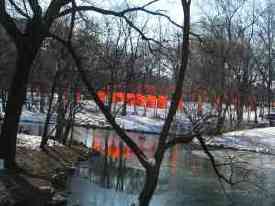August 25, 2005
The Gates: A Visual Literacy Case Study

I came across this fantastic online lecture about the Gates by John Weber, Director of the Tang Museum at Skidmore College. It's called The Gates: A Visual Literacy Case Study. He says things like: "I'm going to guess that more pixels and film were expended on it than have been deployed in the service of any single work of art to date, and while I can't prove it, I'm sure this has to be true. Walking through the Park with a camera in hand it was impossible to avoid taking one picture after another in an attempt to find the perfect summation of the experience." Bravo John, we couldn't agree more.
Posted by kim white at 12:45 PM | Comments (0)
June 7, 2005
Sorting the Pile
The Gates Memory Project blog will remain dormant for the time being as we plan next steps for the archive. As of this writing, there are 3,564 photos collected under the "gatesmemory" tag in Flickr. Contributions have certainly slowed, but new work has continued to trickle in. If you still have images you'd like to be part of the project, it's certainly not too late!
As part of working through our ideas, we've submitted a paper to the 2005 Computers & Writing Online Conference that discusses our experience of creating a networked archive with everyday social software tools. The paper, "Sorting the Pile: Making Sense of A Networked Archive," can be viewed here.
Thanks to all who have contributed. Keep checking back for updates on the project.
Posted by ben vershbow at 5:36 PM | Comments (0)
April 27, 2005
a del.icio.us anthology
The Gates Memory Project now has a del.icio.us bookmark page. We are using it to compile a list of online stories and other ephemera about the Gates project. It will serve as a companion to our Flickr photo archive. To be included, post a comment below with your url, or add the tag "gatesmemory" to your del.icio.us account.
Posted by kim white at 11:35 AM | Comments (0)
April 14, 2005
where do we go from here?
Ben and I have been talking at length about the next step for the gates memory project. We came up with three ideas briefly outlined below. We decided to open up our internal conversation to our readers. Please let us know what you think.
FIRST IDEA
Unless we actively engage them, memories fade.
We've now collected over 3,000 photographs of the Gates in Flickr. Let's try to imagine an interface that captures the perishability of memory and at the same time gives a compelling reason to interact - i.e. if you don't, it will all disappear.
This could work in many ways. Here are two:
1. Rating
Visitors could watch a random slideshow of the archive. Next to each picture there would be sliding meter between "remember" and "forget." If you love the photo you will slide it to the top. If you hate the photo, you will slide it all the way down to forget. Most will choose somewhere in the middle. These actions will be registered on some sort of visualization of the entire archive - a grid, say, with every photo arranged as a small tile. Depending on visitors' actions during the slideshow, some tiles will be brighter than others. Some will have paled slightly, some will be very faded out, and some will have disappeared altogether. The more people visit, the more nuanced this memory map will become, and photos will fluctuate in and out of memory. You can either let it go on indefinitely, or eventually freeze it and voila: your lasting, definitive document.
2. Half Life
This is about imbuing the archive with a sense of decay and steady erosion. The archive is fading away and can only be held onto if people interact with it. It's not so much about rating individual components as keeping contact with the collective. Like a bit torrent, as soon as people abandon it, it dies.
SECOND IDEA
Archives as landscape: this interface allows visitors to "play" with the images to build a collective work of art that reconstructs the Gates photo archives as virtual pathways.
We would turn each of the 3,000+ Gates photos into a tile which can be dragged and dropped onto a surface/screen that is scrollable horizontally and vertically. The object of the game is to layout a string of photos that connect to each other like dominos. Orange bleeding off the side of a photo = a possible connection. Visitors look for images that begin where the last one left off. These progressions can proceed vertically, horizontally or diagonally, growing and spreading as visitors search the archives, finding new connections and adding new tiles. We could also allow users to "edit" the collage, replacing existing photos with better photos.
The Result: threads that build and ribbon across the space will form a kind of virtual memory of movement through the Gates. The landscape of our collage can be examined close up or far away, using a zoom function. Zooming out gives you an aerial view of the Gates, zooming in allows you to see it on the ground level.
GUEST EDITOR PROJECT
We would like to ask guest editors to review the photo archives and select pictures that exemplify a single, specific idea about the Gates. Each editor will have something different to say. Our hope is that a multifaceted understanding of the Gates project will emerge when the various viewpoints are seen/read together.
For the guest editor project, Ben feels strongly, and I agree that this should take place on on our existing blog rather than on a new one. The guest editor project could be a distinct thread on the Gates blog, or it could take over the entire blog (I lean towards the latter). To get the project going, guest editors should send an email to Ben or to me with the contents of their blog post (text and links to the photos they want posted) and we will post it for them. If the project mushrooms and we get several submissions a day, we should talk to Kalina about building a form field for submissions.
Another way to go is to utilize Flickr's "my favorites" function, which allows users to create a page with their favorite photos. We could ask Gates visitors to make a page of favorites and we could create a gallery space on our website to display clickable thumbnails of these pages. The only problem with this option is that the favorites function does not have a space to write commentary, so this would be a strictly visual commentary.
Bob's thoughts
i love the Rating concept -- especially if we could make it work like the baby name site
half-life is interesting, but not clear to me why the archive should die if no one looks at it for awhile -- a key rationale of an archive is to counter ephemerality
the game is OK, but seems forced and a bit trivial as it only draws on the geometry of the photos; i.e. an interesting exercise but not clear what importance it elucidates re:The Gates as a work of art.
agree that if we do the guest photo editor -- which i still think we should because that can be started immediately, while we develop other ideas such as the Rating meter -- that it should be on the existing gates memory blog.
Dan says:
2. Half Life
I like the idea of this. But how do you make something like information-death tangible on the Internet? The internet's made information cheap: we feel like even if one website dies, someone will have a copy somewhere. (This isn't always true, of course - despite the efforts of archive.org, a lot of the internet did prove ephemeral.) How would we do this with Flickr images if a) the images don't belong (a loaded word) to us, and b) they're on Flickr already?
SECOND IDEA: Archives as landscape:
This wouldn't be hard to do - there are a lot of slide puzzles done in Java or JavaScript & we could pull the code apart until it suited our purposes. Is this, though, the sort of project that might be done best by a computer program, then edited by hand? Or maybe have a computer program that does it algorithmically side by side with a human-edited version: the two could be aesthetically compared.
GUEST EDITOR PROJECT
What if we combined a link to Flickr's "my favorites" with a blog post? The editor could write a paragraph or so about what they liked, then there could be a link. Or a thumbnail of the page could be a link if they didn't want to write commentary.
Posted by kim white at 8:42 AM | Comments (0)
March 30, 2005
gates memory project in Time Out NY!

Posted by ben vershbow at 3:58 PM | Comments (0)
March 26, 2005
Video Gates
Via Unmediated, Flickr for Video:

Mefeedia has inconspicuously turned into Flickr for video, at least in terms of tag usage. Several of us that use Mefeedia are putting out a call for people to add videos with the tag "gates", in honor of Christo and Jean Claude's Central Park exhibit.
You can see the start of the compilation here. More and more videos will be added over the next two weeks and we are encouraging anyone who has video of The Gates posted on their site to submit it to Mefeedia.
If you use an RSS reader, you can add this feed to keep up with any new videos that show up with the same tag.
Posted by michal migurski at 11:31 AM | Comments (1)
March 17, 2005
Blogging the Experience
"It's only the gates. A work of art of joy and beauty," -- Jeanne-Claude.
When their creators, Christo and Jeanne-Claude, declared that the Gates had no meaning, they were, in this writers estimation, attempting to get the viewing public to ignore the art-world preoccupation with capital M "meaning" and instead think of art as a catalyst for experience, connection, and pleasure.
My favorite personal essay on the Gates comes from David Patrick Columbia's "New York Social Diary." It's a marvelous explaination of why the Gates are great. Plus, he makes his observations while lunching with NY art-world celebs on a fabulous Central Park South terrace--stunning photos of the bird's-eye view included.
"Meaningful Connections" Blog comes up first on a Google search for "Christo's Gates." It has a small selection of reader experiences. Dan Zukowski's entry was particularly interesting. It documents the conversation he had with himself as he attempted to ignore the hype and experience that Gates as honestly as possible. Here is an excerpt.
Crossing Madison Avenue and 96th street - two blocks from Central Park:
Looming larger - I like the orange color - saffron they call it. Now I see lots of gates. Nice - This is interesting. OK OK A big population of gates. OK Look at that! I see my first shot. See those three gates against the big tree - OK- I feel engaged.
And there were several blogs by people whose experience of the Gates was only through second-hand information, the photographs and stories of others.
Posted by kim white at 11:22 AM | Comments (0)
March 16, 2005
the Gates recycled
 Newsday ran a great article yesterday describing the recycling of the Gates in Nazareth, Pennsylvania at Nicos Polymers & Grinding Inc. Evidently, they are taking great pains to ensure that no materials are stolen while awaiting destruction, and that the nylon mulch and re-ground PVC pipe do not become collector's items in their own right (though this seems inevitable).
Newsday ran a great article yesterday describing the recycling of the Gates in Nazareth, Pennsylvania at Nicos Polymers & Grinding Inc. Evidently, they are taking great pains to ensure that no materials are stolen while awaiting destruction, and that the nylon mulch and re-ground PVC pipe do not become collector's items in their own right (though this seems inevitable).
From a particularly vivid passage in the article:
"Delivery trucks back up to the 180,000-square-foot plant, revealing orange poles stacked floor to ceiling in snug, honeycomb-like symmetry. The other day, the driver of a saffron-colored forklift was off-loading 120 poles at a time while another worker, Hilberto Mendez, handled the grinding.
"Mendez plucked a 16-foot pole from a neat stack and slid it into the maw-like chute of a Cumberland grinder, which distantly resembled an industrial-sized Cuisinart. The grinder swallowed the pole whole, as if it was a 16-foot carrot stick, and with a grating crash chewed it into lightweight orange "gravel," which it spit into a 3-foot cardboard cube."
This ties in nicely to the "gates as labor" discussion that began here the other day.
(Photo by Rick Smith)
Posted by ben vershbow at 5:27 PM | Comments (2)
March 9, 2005
nearly 1,000 photos in just 24 hours!
After just one full revolution of the earth, the Gates Memory Project has amassed almost 1,000 images on its Flickr page. Thanks to all who have submitted so far...
Posted by ben vershbow at 5:10 PM | Comments (0)
The Gates: An Experiment in Collective Memory
So . . . .about two weeks ago I had a dream, (actually more of a nightmare) in which I was asked to judge a contest to choose "the best photograph of the Gates" from among three million orange photos. Over the next few days, however, the more I thought about it,I became intrigued by the idea of seeing people's different creative solutions to photographing the gates.
[Note: I loved the Gates. Ashton (partner-in-crime) and I were in the park almost every day we were in the city, we even gave a party for 150 friends who came from all over the world to walk through the park at dawn (see nifty video by alex itin, orange you glad).
On the last day Ashton and I walked through the park for seven straight hours with Rebeca Mendez and Adam Euwens -- talking almost the whole time about the phenomenon of the Gates -- as an art work that requires significant effort on the part of its audience; like all of Christo and Jeanne-Claude's work, it requires you to be at a certain latitude and longitude at a specific moment in time; you need to see it from different vantage points at different times of the day; as Ashton said, "there are as many views of the Gates as footsteps in the park."
And of course you talk endlessly to the people you meet along the way.
Early that last day, high up on the Harlem Meer, we came upon a big man with red orange hair who was quickly slipping a big coat over his obviously naked body. His friend had just as obviously been taking pictures. Ashton and Rebeca immediately realized that they were taking pictures of his orange pubic hair against the backdrop of the Gates. Impulsively I mentioned that I was planning to sponsor a contest for the best amateur photograph of the Gates. Surprisingly they wrote down a URL for the competition I made up on the spot. A few other times during the day I mentioned this to people who seemed to be taking interesting photos. Without any prompting, they also wrote down the URL.
So the next day, Monday, while sitting around the table with Kim, Dan, and Ben, my colleagues at the Institute for the Future of the Book, I mentioned the whole Gates photo idea and to my delight everyone thought it would fit in perfectly with our experiments in the area of open-ended networked "books."
Voila -- the beginning of the Gates Memory Project which we are launching today at gatesmemory.org. It's quite a bit more ambitious than the original (and impossible) idea of choosing "the best photo." Now we are aiming to to harness the creativity and insight of thousands to build a kind of collective memory machine -- one that is designed not just for the moment, but as a  lasting and definitive document of the Gates and our experience of them. As Ben Vershbow says in the press release announcing the project, "The photographs are a jumping off point for further exploration. Ultimately, we are interested in collecting anything that can be shared over the web - film, audio, text - parodies and remixes."
lasting and definitive document of the Gates and our experience of them. As Ben Vershbow says in the press release announcing the project, "The photographs are a jumping off point for further exploration. Ultimately, we are interested in collecting anything that can be shared over the web - film, audio, text - parodies and remixes."
While the photos and stories are being collected, the institute will encourage discussion and debate on how best to present the archives in hopes of finding new, unexpected ways to view and bring meaning to the content. The institute also welcomes the possibility of collaboration with designers, developers and web curators. This project is the beginning of a long-term exploration for us. Through this work, we are asking: how do we use social software to create works that are in the spirit of the web - i.e. free-form, ad hoc, always evolving, and driven by people's enthusiasm to share - but are also edited and shaped into something of lasting value? It is that tension - between frozen and fluid works - that we aim to explore. We are excited to see the ideas people will bring to the table.
See the complete call for the project HERE.
Posted by bob stein at 1:07 PM | Comments (0)
March 8, 2005
introducing the Gates Memory Project blog
What are we building? How are we going to build it? How should it be organized? What should it look like?
An integral part of the Gates Memory Project is a public space for discussion of these meta issues. Everyone will have a chance to suggest possible directions and designs for the project. Some will bring technical knowledge to the table. Others will advise more on our conceptual bearings. Others will just come along for the ride. We'll also examine the process of building a work of collective memory in digital space, using the Gates as a pivot point for larger contemplations. How do we use social software (like Flickr) to create works that are in the spirit of the "infinite game" of the web - i.e. free-form, ad hoc, always evolving, and driven by people's enthusiasm to share - but are also edited and shaped into something of lasting value?
It could be argued that the web is itself one enormous collective memory. Like memory, it is in a constant state of growth, transformation and decay. Like memory, it is layered, it sprawls, and is traversed both by brightly lit boulevards and shadowed alleyways. To cope with this enigma, humans have always created works that help fix or focus the memory. An obvious example is a book, painting, photograph, or film. Similarly, in public space, we have museums, memorials, and monuments. Certainly, there was something monumental about the Gates. But while some monuments fix a spike in the earth, as if to say "here it was," others establish a frame, or space, in which memories can move and reverberate. This second sort of monument, much more like the Gates, is a good place to start thinking about what we are trying to build with this project: a work with defined dimensions that still allows for unpredictable movement within, and which, like a great acoustical structure, is designed to resonate.
And of course, the blog will also serve as a forum for discussion of the Gates themselves - their design, their politics, their message, their role in the life of the city, their place in the larger mediascape.. And it will be a place to offer stories and personal meditations on those sixteen days when the Gates stood.
Posted by ben vershbow at 4:02 PM | Comments (4) | TrackBack

